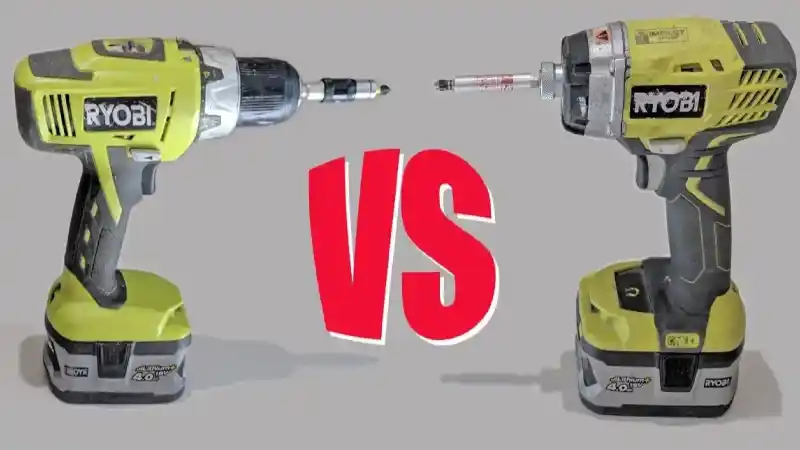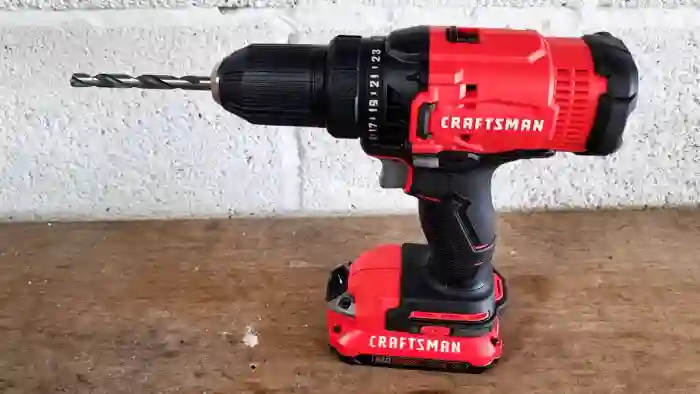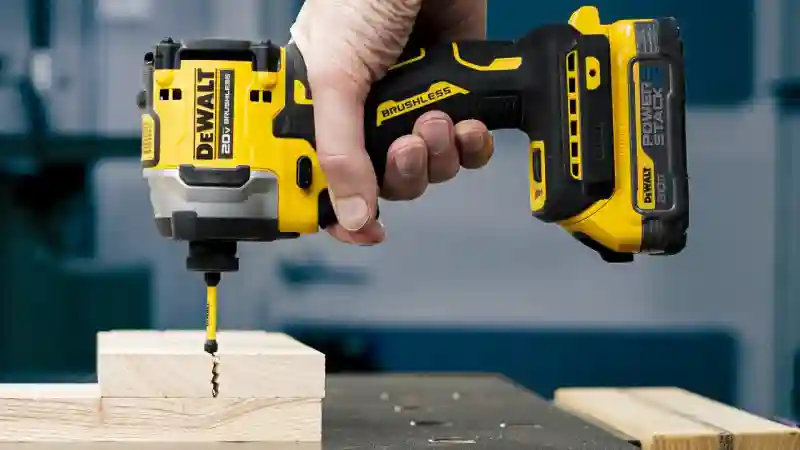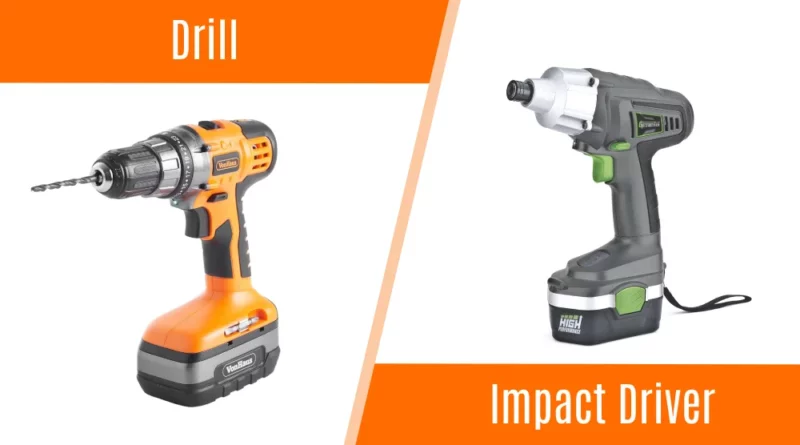Drill vs. Impact Driver | Major Differences
TheToolGeeks.com is a participant in the Amazon Services LLC Associates Program and other affiliate advertising programs. We may earn from qualifying purchases. (Learn More).
The “drill vs. impact driver” debate can’t be overlooked if you’re in the market for a new power tool. Each tool has unique strengths and capabilities, making them essential for any woodworker, DIY enthusiast, or professional. But have you ever wondered which one best fits your DIY needs?
Realizing their key differences and knowing when to reach for one or the other can ensure the successful completion of any project. Impact drivers deliver higher torque levels for driving screws into tough materials efficiently. However, drills are versatile for drilling and driving tasks with adjustable torque levels.
In this comprehensive guide, we’ll dig deep into the intricacies of these two powerhouses so that you can make an informed decision. Keep reading to uncover the secrets behind selecting the perfect tool for your next project.
Jump To Page Contents:
Major Differences Between Drill vs. Impact Drive

Consider the following differences for your project needs when comparing a drill and an impact driver:
- Size and compactness
- Mechanism of action
- Torque and control
- Weight distribution
- Gears and speed settings
- Chuck compatibility
- Noise level
- Bit compatibility
- Battery efficiency
- Versatility
Size and Compactness
Comparatively, the impact driver’s compact design offers significant advantages over the bulkier drill, particularly in confined workspaces or when overhead tasks are involved.
Impact drivers are notably shorter and more maneuverable than drills, allowing for better access to tight areas and reducing user strain. Their smaller size makes them easier to handle, decreasing fatigue during prolonged use.
In contrast, with their larger and bulkier build, drills may be cumbersome in confined spaces and challenging to maneuver overhead. The compactness of impact drivers enhances user comfort and increases overall efficiency, making them a preferred choice for tasks that demand agility and precision.
Mechanism of Action
The drill operates by whirling the chuck in one direction, allowing for drilling holes and driving screws at variable speeds controlled by the trigger. It employs gears to adjust torque levels and features a clutch for precise control, making it suitable for delicate tasks.
Meanwhile, the impact driver utilizes a unique mechanism combining rotational force with impact bursts to drive fasteners more efficiently. It delivers significantly higher torque levels compared to drills, ideal for driving long, wide, and large screws into wood.
Torque and Control
Drills and impact drivers have different torque and control capabilities, affecting their efficiency. Drills, equipped with adjustable clutches, offer precise control over torque levels. This feature makes them suitable for tasks requiring delicate handling and helps prevent overdriving screws.
However, impact drivers lack a clutch mechanism, increasing the risk of overdriving screws if not handled carefully. However, they compensate by delivering higher torque levels, making them more efficient for driving fasteners with greater resistance.
Weight Distribution
The weight distribution in impact drivers allows for better control and precision when driving screws or fasteners, especially in overhead or tight spaces. With the weight centered towards the handle, these drivers are easier to handle for extended periods, decreasing strain on your wrist and arm muscles.
In contrast, with their bulkier design and more uniform weight distribution, drills provide a stable platform for drilling tasks requiring a steady hand. The difference in weight distribution between these tools directly impacts how they feel in your hand and perform in various applications.
Gears and Speed Settings
Regarding gears and speed settings, the drill and impact driver present distinct features that cater to varying task requirements and user preferences.
Drills offer adjustable gears for speed and torque settings, providing flexibility and versatility to handle various tasks. This feature allows users to fine-tune the tool based on the specific needs of the job at hand.
In contrast, impact drivers typically lack gear settings and rely on variable speed control through the trigger. While this simplifies operation, it may limit the tool’s adaptability in certain situations requiring precise torque adjustments.
Chuck Compatibility
Chuck compatibility between drills and impact drivers significantly influences the types of accessories that can be utilized with each tool. Drills commonly come with a three-jaw chuck that can accommodate various drill bit sizes, providing versatility for different applications.
In contrast, impact drivers are designed with a quarter-inch hex chuck, necessitating compatible hex bits for operation. While this setup may limit the range of accessories used with an impact driver, it enhances the tool’s compactness and efficiency.
Noise Level
When comparing the noise levels of a drill and an impact driver, consider their distinct characteristics and operating mechanisms. Drills typically produce less noise than impact drivers, although they still generate audible sounds, especially when drilling into tougher materials.
Impact drivers, known for their higher torque applications, tend to be louder due to the impact mechanism. However, some impact driver models offer quieter options to address noise concerns.
Bit Compatibility
Considering the bit compatibility between a drill and a driver, consider their differences in accommodating various types and sizes of drill bits. A drill offers versatility, accepting a wide range of bit sizes and types like twist drills, spade bits, and hole saws, depending on the chuck size and design.
On the other hand, impact drivers are designed to work with hex-shank bits exclusively due to their quarter-inch hex chuck design. While this limits the variety of bits that can be utilized, it ensures a secure grip and efficient power transfer during fastening tasks.
Battery Efficiency
Understanding the fundamental differences between a drill and an impact driver is essential to maximize battery efficiency. Drills equipped with battery types like NiCad, NiMH, or Li-ion consume more power due to their continuous rotational motion.
In contrast, impact drivers are designed to be higher battery-efficient. Their unique impact mechanism delivers intermittent bursts of force, reducing overall power consumption. This efficiency results in longer battery life when compared to drills performing similar tasks.
Opting for an impact driver could be advantageous if you prioritize longer usage time and reduced battery changes. Impact drivers intermittently excel in tasks requiring high torque, making them a practical choice for many professionals and DIY enthusiasts.
Versatility
Drills are multifunctional tools suitable for both drilling and driving tasks. They can be equipped with various attachments to bore holes in different materials and drive screws of varying sizes.
On the other hand, impact drivers are specialized for driving fasteners efficiently. While impact drivers may not offer the same level of versatility as drills, they excel in driving screws into dense materials with high torque.
An impact driver will be optimal if your projects involve many fastening tasks. However, a drill would be more suitable for a more versatile tool that can handle drilling and driving operations.
Comparison Table Between Drill and Impact Driver
| Feature | Drill | Impact Driver |
| Generally larger and bulkier | Significantly shorter and more compact | |
| Mechanism of Action | Operates by spinning the chuck in one direction | Employs a unique mechanism that combines rotational force with bursts |
| Torque and Control | Precise control over torque levels | Lacks a clutch mechanism, delivers higher torque levels |
| Weight Distribution | Distribute weight more evenly across the tool | Lighter and more compact, with weight concentrated towards the handle |
| Gears and Speed Settings | Equipped with gears that allow users to adjust both speed and torque settings | Lack of similar gear settings |
| Chuck Compatibility | Features a three-jaw chuck | Utilizes a quarter-inch hex chuck |
| Noise Level | Less noise during operation | Generates louder and more distinct noise |
| Bit Compatibility | Accommodates a wide range of drill bit sizes and types | Compatible only with hex-shank bits |
| Battery Efficiency | It can be equipped with various battery types | Designed to be more battery-efficient |
| Versatility | Performing both drilling and driving tasks | Designed for driving fasteners and excels |
Drill or Impact Driver: How Do I Choose the Suitable One for My Work Type?
When deciding between a drill and a driver, consider the nature of your task:
Drill

When selecting between a drill, consider the following work type at hand:
Boring Holes
Drills excel at providing accurate and clean holes due to their adjustable speed and torque settings. When working on tasks that require precise hole placement and consistent depth, a drill is the preferred choice for optimal results.
Delicate Fastening
Considering the need for precise control over delicate fastening tasks, a drill equipped with adjustable clutch settings emerges as the optimal choice.
The clutch feature allows you to set the desired torque level, reducing the risk of damaging small or delicate fasteners. This precise control helps prevent over-tightening, ensuring the integrity of the fastener and the workpiece.
Soft Materials
A drill is suitable for soft materials such as drywall, plywood, or thin metal when precise control is paramount and high torque isn’t required. Drills excel in driving screws into these materials, providing the necessary accuracy while preventing damage.
When working with delicate surfaces that demand finesse over brute force, opting for a drill ensures a smooth and controlled fastening process.
Impact Driver

When deciding whether to use an impact driver, consider the nature of the task at hand:
Driving Fasteners
To determine whether to utilize an impact driver when driving fasteners, assess if your project involves screws into dense materials like hardwood, treated lumber, or metal.
Impact drivers excel in these situations due to their high torque output and efficient impact mechanism, making them faster and easier to use. For projects involving dense materials, an impact driver is an ideal tool for driving fasteners effectively.
Heavy-Duty Applications
Assess your heavy-duty applications to determine if an impact driver is a suitable tool based on the type of work involved.
For tasks like building decks, framing walls, or installing subfloors that require driving numerous fasteners quickly and efficiently, the power and speed of an impact driver excel. This tool reduces fatigue and speeds up the job, making it ideal for demanding applications where efficiency is crucial.
Tight Spaces
An impact driver’s compact size and lightweight design offer increased convenience and comfort for extended use in tight spaces. Its maneuverability is especially beneficial in confined or overhead areas where a drill may be too bulky or challenging to operate.
When working in such environments, opting for an impact driver can significantly improve efficiency and ease of use, making it suitable for these work conditions.
Is it OK to use an impact driver as a drill?
Impact drivers can be used for drilling holes, but they’re primarily designed for driving screws. While some models have a drill setting, they lack the precision and versatility of traditional drills.
Impact drivers deliver high torque in bursts, making them ideal for driving long screws into tough materials. Still, this mechanism can cause the bit to slip on smoother surfaces, leading to less accurate drilling. The impact mechanism also strains the bit and can cause it to break more easily when drilling harder materials.
What types of projects are best suited for a drill?
Consider the projects that involve drilling holes in various materials such as wood, metal, or plastic when determining the best-suited applications for a drill.
Drills excel in tasks requiring the creation of holes for screws, bolts, or dowels. They’re essential for woodworking projects like assembling furniture, installing shelves, or building structures where precise and clean holes are necessary.
When working with metal, drills are indispensable for tasks such as mounting brackets, creating holes for wiring, or installing fixtures. Drills make openings for cables, pipes, or fasteners in plastic fabrication or repair projects.
When should I choose an impact driver over a drill?
For tasks involving driving screws or fasteners into tough materials like hardwood, concrete, or metal, opt for an impact driver over a drill. Impact drivers are specifically designed for such scenarios, where high torque is required to drive screws into dense materials efficiently.
Their internal mechanism provides rotational force combined with concussive blows, allowing them to power through challenging applications easily. Impact drivers excel in speed and effectiveness when dealing with large or long screws that demand significant torque to prevent stripping or stalling.
Why do I need both an impact driver and a drill?
To tackle a wider range of tasks efficiently and effectively, having an impact driver and a drill in your toolkit is essential.
Cordless drills handle smaller holes and drive smaller fasteners to consistent depths. They’re versatile tools suitable for various tasks, such as assembling furniture, drilling pilot holes, and installing fixtures.
On the other hand, impact drivers are primarily designed for larger holes and driving longer or larger fasteners. Their high torque output makes them ideal for building decks, framing houses, or working with stubborn fasteners.
The Right Tool for the Task: Choosing Between a Drill and an Impact Driver
The choice between a drill and an impact driver ultimately comes down to the nature of your work. For those completing a broad range of projects, the all-purpose application of a traditional drill may be the best starting point.
The flexibility to adjust torque settings and use various bit types adds an unmatched level of adaptability and precision. However, if you often work with more resilient materials or on jobs demanding frequent fastening, you’ll find the impact driver a reliable and powerful companion.
Its capacity to deliver high-torque force swiftly and securely can significantly reduce project time and effort. While both tools have their strengths, the mark of a skilled craftsman often lies in their ability to select the right tool for the task at hand.
Amazon and the Amazon logo are trademarks of Amazon.com, Inc, or its affiliates.

